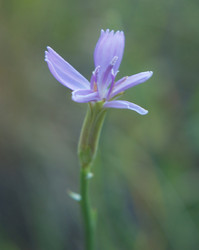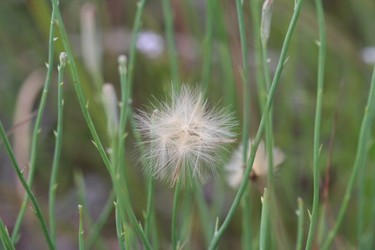Lakota Name: caŋĥlóġaŋ hu caŋ swúla uŋ he tukťėkťel yuke -meaning: Small weed stem that exists here and there. Listen to Lakota Name: caŋĥlóġaŋ hu caŋ swúla uŋ he tukťėkť yuke
Listen to Lakota Name: caŋĥlóġaŋ hu caŋ swúla uŋ he tukťėkť yuke
Scientific name: Lygodesmia juncea
Common name: Skeleton weed
Medical Use: Skeleton weed was employed medicinally by various native North American Indian tribes who used it particularly as a galactogogue. A galactogogue is a substance which is used to increase the production of milk in humans and other animals. Skeleton weed is not often used as a medicinal herb in modern times. The leaves and stems are galactogogue and tonic. An infusion of the stems has been used to promote milk flow in nursing mothers, in the treatment of smallpox, measles, kidney problems, diarrhea, heartburn and burning coughs and also as a general tonic for children. A poultice of the plant has been applied to bring relief to rheumatic and swollen joints. An infusion has been used as a wash for sore eyes. An infusion of the powdered galls that are found on the plant is diuretic.
Description: Stems up to 50 cm tall, glabrous (having no hairs, projections, or pubescence; smooth), erect (being in a vertical, upright position) branching with milky sap. Leaves alternate, cauline (having, or growing on a stem), leaves reduced and scale like, scabrous (having or covered with scales or small projections and rough to the touch) and subulate (tapering to a point; awl-shaped).



Lygodesmia juncea flower courtesy National Park Sercice, seedheads © 2007 Brian Peterson
Seeds: used as gum for chewing.
Flower: Single pink flower heads about one-half inch wide appear at the tips of the branches. Each head contains five flowers.
Global Distribution: North America, Wisconsin and Alberta to Texas.
South Dakota Distribution: common in the dry to moist prairie over the state.
Habitat: The plant prefers lightly sandy, loamy soils and requires well drained soils. It cannot grow in the shade.
I could not find any modern research on plant or active ingredient.



 Go to quick links
Go to quick search
Go to navigation for this section of the ToL site
Go to detailed links for the ToL site
Go to quick links
Go to quick search
Go to navigation for this section of the ToL site
Go to detailed links for the ToL site